Harmless Watersnake or Venomous Water Moccasin?
There are many harmless watersnakes (genus Nerodia) that are frequently confused with venomous Water Moccasins a.k.a. Cottonmouths (Agkistrodon piscivorus). Sadly, harmless snakes are often killed out of fear for the safety of family and pets. Most people, even those who aren't afraid of snakes, would feel safer if they knew how to rapidly identify snakes near water as harmless or venomous. So how can you tell them apart?
| Harmless Watersnake |
Venomous Water Moccasin |
|
| Usually found near water? | YES | YES |
| Body shape is... | SLENDER | HEAVY |
| Body dark, often with bands? | YES | YES |
| Rough-looking, keeled scales? | YES | YES |
| Head shape is... | SLENDER or FLATTENED | THICK, BLOCKY |
| Neck is... | NOT DISTINCT | NARROWER THAN HEAD |
| Dark facial band or eyestripe? | MAYBE | YES |
| Eye pupil type is... | ROUND | VERTICAL |
| Heat-sensing pits on face? | NO | YES |
CAUTION! -- With practice, you can learn to tell the difference between watersnakes and Water Moccasins. Even non-venomous watersnakes will bite, so the best policy for dealing with snakes is to "leave them be" to play their important roles in our ecosystem.
Best ways to tell watersnakes and Water Moccasins apart:
1. BODY SIZE
THICK, HEAVY BODIES: Venomous Water Moccasins have bodies that are VERY thick and heavy for their length, and short, thick tails. A harmless snake the same length would be much more slender and would have a much longer, thinner tail (see below).
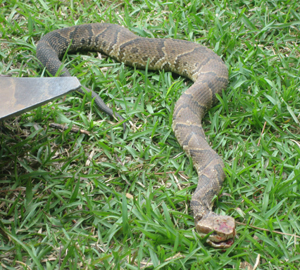
The body of this young, venomous Water Moccasin is very thick for its length, and has a relatively short, thick tail. Notice that the head is also thick and blocky. Older adults are often much darker -- almost solid black. (Note: this photo was sent to us by an Extension client who needlessly killed the snake and asked that we confirm that it was a venomous species. However, by killing the snake they greatly increased their chances of being bitten--it is always best to leave snakes alone!)
LONG, SLENDER BODIES: Non-venomous watersnakes (and other harmless snakes) have bodies that are more slender for their length, and longer tails.
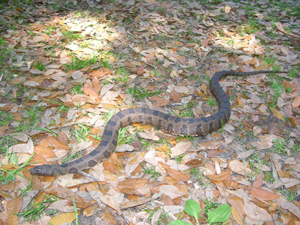
This Brown Watersnake has a slender body and has a relatively long, thin tail. Notice that the head is also narrow.
**FLATTENED BODY: harmless watersnakes often flatten their bodies and heads when they feel threatened, making themselves look much larger and more menacing.
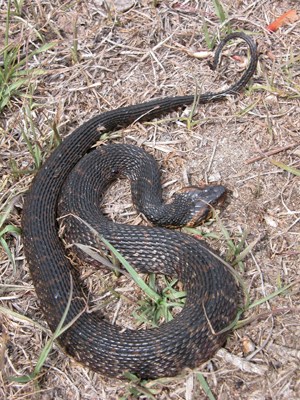
This Banded Watersnake feels threatened and is flattening its body and neck. However, for its length, the body of this snake is still more slender than the body of a water moccasin, AND the tail is much longer and thinner.
2. HEAD AND NECK SIZE AND SHAPE
LARGE, BLOCKY HEADS: Venomous Water Moccasins have large, blocky heads and their necks are distinctly narrower than their heads.
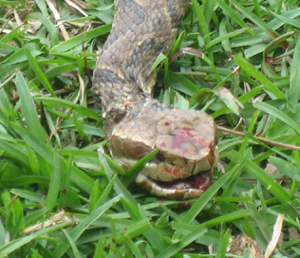
This venomous Water Moccasin has an obviously thick, (top to bottom) blocky head. (Note: this photo was sent to us by an Extension client who needlessly killed the snake and asked that we confirm that it was a venomous species. However, by killing the snake they greatly increased their chances of being bitten--it is always best to leave snakes alone!)
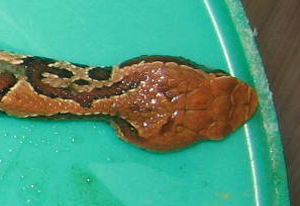
This venomous, juvenile Water Moccasin also has a wide, blocky head, and a very obvious neck that is narrower than the head. (Note: this photo was sent to us by an Extension client who needlessly killed the snake and asked that we confirm that it was a venomous species. However, by killing the snake they greatly increased their chances of being bitten--it is always best to leave snakes alone!)
SLENDER HEADS: Harmless watersnakes have slender heads that are more narrow and less blocky, and they lack obvious necks.
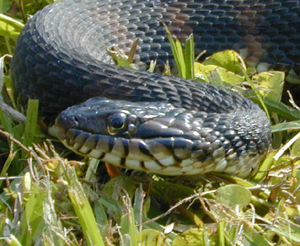
This Banded Watersnake has a slender, elongate head that blends into the body smoothly, with no obvious neck.
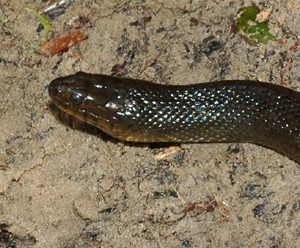
This Green Watersnake also has a slender head and no distinct neck.
FLATTENED HEADS: Harmless watersnakes often flatten their heads into a triangular shape when they feel threatened, but their heads look flattened rather than thick and blocky, and their necks are not distinctly narrower than their heads.
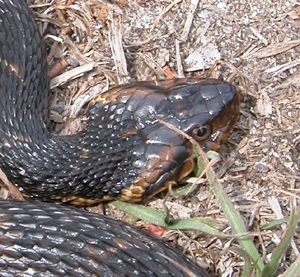
This Banded Watersnake feels threatened, so it has flattened its head and body to appear more menacing. Harmless watersnakes often flatten their heads when they feel threatened, making their head look triangular--but notice that the head looks flattened, not thick and blocky, and the neck is almost as wide as the head.
Want to learn more? Visit our Dealing with Snakes page...